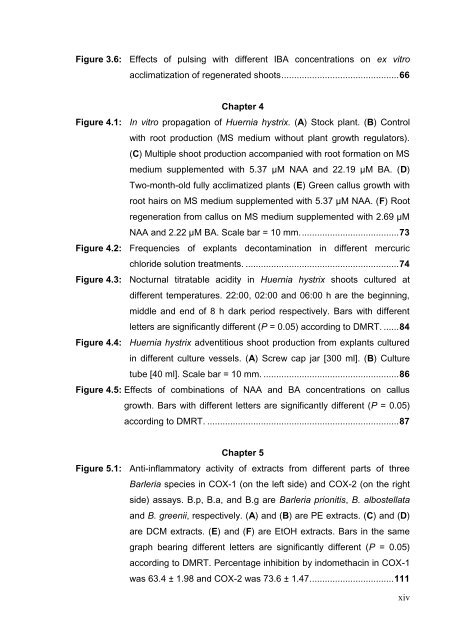Micropropagation and medicinal properties of Barleria greenii
Micropropagation and medicinal properties of Barleria greenii
Micropropagation and medicinal properties of Barleria greenii
Create successful ePaper yourself
Turn your PDF publications into a flip-book with our unique Google optimized e-Paper software.
Figure 3.6: Effects <strong>of</strong> pulsing with different IBA concentrations on ex vitro<br />
acclimatization <strong>of</strong> regenerated shoots .............................................. 66<br />
Chapter 4<br />
Figure 4.1: In vitro propagation <strong>of</strong> Huernia hystrix. (A) Stock plant. (B) Control<br />
with root production (MS medium without plant growth regulators).<br />
(C) Multiple shoot production accompanied with root formation on MS<br />
medium supplemented with 5.37 µM NAA <strong>and</strong> 22.19 µM BA. (D)<br />
Two-month-old fully acclimatized plants (E) Green callus growth with<br />
root hairs on MS medium supplemented with 5.37 µM NAA. (F) Root<br />
regeneration from callus on MS medium supplemented with 2.69 µM<br />
NAA <strong>and</strong> 2.22 µM BA. Scale bar = 10 mm. ...................................... 73<br />
Figure 4.2: Frequencies <strong>of</strong> explants decontamination in different mercuric<br />
chloride solution treatments. ............................................................ 74<br />
Figure 4.3: Nocturnal titratable acidity in Huernia hystrix shoots cultured at<br />
different temperatures. 22:00, 02:00 <strong>and</strong> 06:00 h are the beginning,<br />
middle <strong>and</strong> end <strong>of</strong> 8 h dark period respectively. Bars with different<br />
letters are significantly different (Ρ = 0.05) according to DMRT. ...... 84<br />
Figure 4.4: Huernia hystrix adventitious shoot production from explants cultured<br />
in different culture vessels. (A) Screw cap jar [300 ml]. (B) Culture<br />
tube [40 ml]. Scale bar = 10 mm. ..................................................... 86<br />
Figure 4.5: Effects <strong>of</strong> combinations <strong>of</strong> NAA <strong>and</strong> BA concentrations on callus<br />
growth. Bars with different letters are significantly different (Ρ = 0.05)<br />
according to DMRT. ........................................................................... 87<br />
Chapter 5<br />
Figure 5.1: Anti-inflammatory activity <strong>of</strong> extracts from different parts <strong>of</strong> three<br />
<strong>Barleria</strong> species in COX-1 (on the left side) <strong>and</strong> COX-2 (on the right<br />
side) assays. B.p, B.a, <strong>and</strong> B.g are <strong>Barleria</strong> prionitis, B. albostellata<br />
<strong>and</strong> B. <strong>greenii</strong>, respectively. (A) <strong>and</strong> (B) are PE extracts. (C) <strong>and</strong> (D)<br />
are DCM extracts. (E) <strong>and</strong> (F) are EtOH extracts. Bars in the same<br />
graph bearing different letters are significantly different (P = 0.05)<br />
according to DMRT. Percentage inhibition by indomethacin in COX-1<br />
was 63.4 ± 1.98 <strong>and</strong> COX-2 was 73.6 ± 1.47. ................................ 111<br />
xiv

















